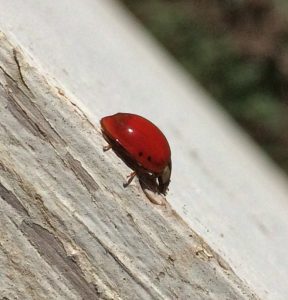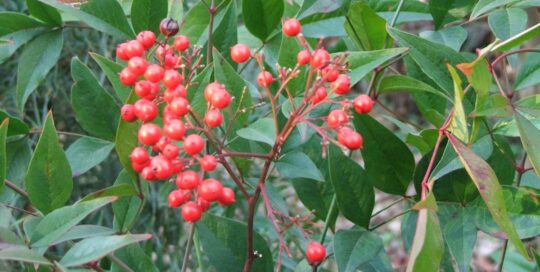Ladybug, Ladybug, Fly Away Home
Views: 1422

“What is up with all these ladybugs?” the delivery man asked standing on my porch, brushing one off his arm as others swarmed the wood railings on my porch and the vinyl siding on my house. It was a lovely warm fall day, and the soaring temperatures seem to have brought them out in clouds.
“Careful,” I warned him. “They bite!” I knew this from unpleasant personal experience.
He shook his head. “I like ladybugs, but this is a bit much!”
I could only agree. Aphids, mites, and scale insects – ladybugs’ food – are no friends of mine. But swarms of smelly, biting ladybugs were causing me more than a little consternation.
This was my introduction to the Asian lady beetle, Harmonia axyridis, also known as harlequin lady beetles, or multicolored Asian lady beetles (MALB).
Asian Lady Beetles
The government originally introduced Asian lady beetles to the U.S. in the early 1900’s to help control agricultural pests. These early introductions were unsuccessful at establishing populations so additional releases were attempted over the years. Based on the multitude of tiny red visitors crawling all over my house, I think it’s safe to say that the government’s efforts became a rousing success at some point. Harmonia axyridis is here to stay. This is probably not good news for native ladybugs since Asian ladybugs are larger and more aggressive and are likely to out-compete them, but it may be good for agriculture, since fewer pesticides may be needed to protect crops.

Asian lady beetles can be identified by the dark “M” or “W” (depending on which direction you look at it) right behind the head. The number of black spots vary, and they can range in color from red, to orange, to almost yellow.
Apparently, my experience this fall is fairly typical for Harmonia axyridis. They fly in swarms on warm, fall afternoons following frigid mornings, seeking shelter for the winter. In their native habitat, they might crawl deep into rock crevasses. In this, their not-so-native habitat, they substitute my light-colored house and sheltered porch for a boulder.
More of a Nuisance
Because lady beetles don’t do damage to furnishings and structures like ants or termites might, they are generally considered more of a nuisance than a hazard. However, when threatened, they can release a smelly, yellow fluid designed to deter predators. This can be rage-inducing to a home owner. Many Asian lady beetles have met their demise in the suffocating bags of vacuums. (When it comes to humans, the smelly-yellow-fluid-release protection strategy is counterproductive.)
Since that day on the porch with the delivery man, I’ve had several warm afternoons with flights of Asian lady beetles, but none with quite as many as that day. Thankfully, we haven’t had them get inside the house, and I am not too upset that they found their way inside a shed.
While I love my native ladybugs, I have mixed feelings about these foreign invaders. I’m glad they will protect my gardens and trees from aphids, mites, and scale, but I could really do without their yellow bug trails and nipping bites. And, truly, just their overwhelming numbers. So, I might wish: “Ladybug, ladybug, fly away home.” Unfortunately, they are already there.
Meet Leslie Miller
Leslie Ann Miller shares 3.5 acres in rural Oklahoma with birds, butterflies and wide variety of animals. She is currently transforming her yard with plantings…
Leslie's Recent Posts

Nandina Berries Are Potentially Harmful to Birds: A Warning






